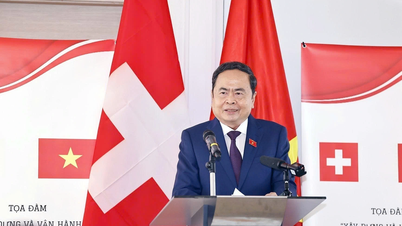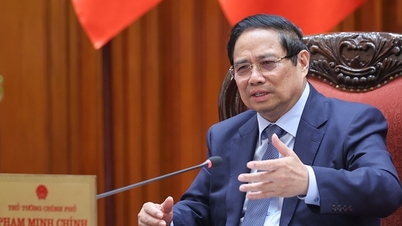World Euro exchange rate today 5/4/2025
The EUR/USD pair remained under slight downward pressure for the second consecutive week, but stabilized at around 1.1350 at the end of the week, almost unchanged from the start of the week. Investor caution towards the US dollar remained, due to concerns about the impact of the White House's tariff policy on the domestic economy .
Meanwhile, recently released US economic data showed that economic activity weakened in the first quarter, partly reflecting the impact of trade tensions. In contrast, EU economic figures, while not as impressive, paint a relatively more positive picture.
Market attention turned to global trade issues and upcoming announcements from the US Federal Reserve (Fed) on monetary policy later in the week. The European Union reported that its Economic Sentiment Index for April fell to 93.6 from 95.00 the previous month. However, the region's first-quarter GDP grew by 1.2% year-on-year and 0.4% quarter-on-quarter, beating market expectations. The Harmonized Consumer Price Index (HICP) also rose by 2.2% year-on-year in April, beating the forecast of 2.1%.
In Germany, retail sales fell 0.2% in March, better than the forecast of -0.4%. First-quarter GDP grew 0.2%, matching forecasts and improving from a contraction in the final quarter of 2024. German inflation hit 2.2% in April, lower than the previous month but still above forecasts.
Still, these numbers are not enough to rule out a rate cut. Several ECB officials have signaled a dovish tone, saying a 25 basis point cut in June is likely. Olli Rehn has suggested that a deeper cut than neutral is needed to support the economy. Philip Lane has been more cautious, not committing to a specific target but admitting that growth will slow slightly.
Amid a weak economy and protracted trade conflict, deeper interest rate cuts are increasingly becoming an inevitable option.
Recent US economic data has been quite negative, making it impossible for the USD to maintain its upward momentum despite signs of easing global trade tensions.
The CB Consumer Confidence Index fell to 86 in April, its lowest since October 2021. First-quarter GDP was -0.3%, compared with expectations for a 0.4% increase, down sharply from the previous quarter's 2.4% increase. The ISM Manufacturing PMI also weakened, coming in at 48.7 in April, down from the previous month but still above market expectations.
Inflation in the US also cooled. The personal consumption expenditures (PCE) price index rose 2.3% year-on-year in March, down from 2.5% in February. The core PCE rose 2.6%, in line with expectations but down from 3% in the previous month.
The labor market has shown signs of weakness. The ADP report showed just 62,000 new private sector jobs in April, far below expectations. The JOLTS data showed job openings in March fell to 7.19 million, missing expectations. Meanwhile, the number of jobless claims rose to 241,000 in the last week of April, higher than expected.
However, the Non -Farm Payrolls (NFP) report released over the weekend provided a rare bright spot, showing that the US economy added 177,000 new jobs in April, beating expectations. The unemployment rate held steady at 4.2%, while annual wage growth held steady at 3.8%, slightly below forecasts.
There is little on the economic calendar in the coming days. The US will release its Services PMI for April, which is expected to decline slightly to 50.6 from 50.8 the previous month. In Europe, investors will focus on German Factory Orders and Eurozone Retail Sales data.
The most important event is the Federal Reserve's monetary policy meeting on Wednesday. The Fed is expected to keep interest rates unchanged at the current range of 4.25% to 4.50%. With economic activity slowing and inflation still a concern, the Fed is likely to remain cautious and wait for clearer data before changing policy.
Chairman Jerome Powell may continue to emphasize a "wait and see" stance during a press conference, while avoiding directly answering questions about his relationship with President Donald Trump.

Domestic Euro exchange rate today 5/4/2025
VIB Bank is buying Euro cash at the lowest price of 27,196 VND/EUR
VIB Bank is buying Euro transfers at the lowest price of 27,296 VND/EUR
SHB Bank is buying Euro cash at the highest price of 29,466 VND/EUR
SHB Bank is buying Euro transfers at the highest price of 29,466 VND/EUR
VIB Bank is selling Euro cash at the lowest price of 28,279 VND/EUR
VIB Bank is selling Euro transfers at the lowest price of 28,179 VND/EUR
OCB Bank is selling Euro cash at the highest price of 30,628 VND/EUR
OCB Bank is selling Euro transfers at the highest price of 30,528 VND/EUR
Source: https://baonghean.vn/ty-gia-euro-hom-nay-4-5-2025-giam-2-tuan-lien-tiep-10296470.html





























![[Photo] National Assembly Chairman attends the seminar "Building and operating an international financial center and recommendations for Vietnam"](https://vphoto.vietnam.vn/thumb/1200x675/vietnam/resource/IMAGE/2025/7/28/76393436936e457db31ec84433289f72)






































































Comment (0)